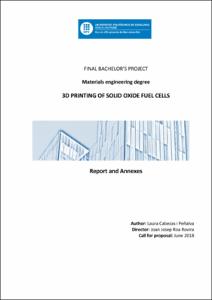Mostra el registre d'ítem simple
3D printing of solid oxide fuel cell
| dc.contributor | Roa Rovira, Joan Josep |
| dc.contributor.author | Cabezas i Peñalva, Laura |
| dc.contributor.other | Universitat Politècnica de Catalunya. Departament de Ciència dels Materials i Enginyeria Metal·lúrgica |
| dc.date.accessioned | 2019-10-23T12:55:50Z |
| dc.date.available | 2019-10-23T12:55:50Z |
| dc.date.issued | 2018-06-21 |
| dc.identifier.uri | http://hdl.handle.net/2117/170721 |
| dc.description.abstract | Nowadays, 3D printing is booming as a processing technique, thanks to its versatility in the manufacture of complex geometries and with a quality finish, which cannot be obtained using traditional techniques and can reduce the costs of table-processing (such as, for example, surface finishing, etc.). With this technology, the aim is to bring science and society closer together, with the ultimate goal of developing new devices that are much more efficient than the current ones in order to produce clean energy. Specifically, in the field of energy and in particular in 3D printing of solid oxide fuel cells, since the fuel used is derived from hydrogen in contact with air to produce energy and water vapour. Therefore, this technology avoids the generation of greenhouse gases, such as CO2. The purpose of this final Bachelor’s project (TFG) is the combination of these two fields, focusing on the electrolyte printing of solid oxide fuel cells, with the main objective of obtaining the final material with microstructural and mechanical properties similar to those obtained by traditional techniques. Nevertheless, through this Bachelor’s project, a new research field will be implemented within the CIEFMA group (Centre for Structural Integrity and Reliability of Materials) of the Department of Materials Science and Metallurgic Engineering UPC's , with the future long term purpose of getting all the parts of the battery printed; electrolyte, cathode and anode. To carry out this study, two geometries have been chosen, tubular and hexagonal, where the proportions of the printing material, processing conditions, etc. have been modified in order to achieve materials with a relative density higher than 99% and mechanical properties similar to the theoretical values of the materials used, by means of technical characterization advances (for example: electron microscopy, nanoindentació, etc.). Subsequently, the cathode was deposited by dip-coating and adhesion was studied by means of nanometric scale scratch-out tests. A density greater than 99% has been obtained with a hardness and modulus of elasticity of the printed material comparable to the theoretical value obtained by conventional forming techniques. The cathode also has good adhesion to the electrolyte, since no cracks or other mechanisms of damage to the interface can be observed through the optical microscope |
| dc.language.iso | eng |
| dc.publisher | Universitat Politècnica de Catalunya |
| dc.rights | Attribution-NonCommercial-NoDerivs 3.0 Spain |
| dc.rights.uri | http://creativecommons.org/licenses/by-nc-nd/3.0/es/ |
| dc.subject | Àrees temàtiques de la UPC::Enginyeria dels materials |
| dc.subject.lcsh | Solid oxide fuel cells |
| dc.subject.lcsh | Three-dimensional printing |
| dc.subject.other | Materiales para la energía |
| dc.subject.other | SOFC |
| dc.subject.other | Impresión 3D |
| dc.subject.other | Caracterización microestructural y micromecánica |
| dc.title | 3D printing of solid oxide fuel cell |
| dc.type | Bachelor thesis |
| dc.subject.lemac | Piles de combustible d’òxid sòlid |
| dc.subject.lemac | Impressió 3D |
| dc.subject.lemac | Piles de combustible d’òxid sòlid |
| dc.identifier.slug | PRISMA-133386 |
| dc.rights.access | Open Access |
| dc.date.updated | 2019-05-30T07:42:19Z |
| dc.audience.educationlevel | Grau |
| dc.audience.mediator | Escola d'Enginyeria de Barcelona Est |
| dc.audience.degree | GRAU EN ENGINYERIA DE MATERIALS (Pla 2010) |


